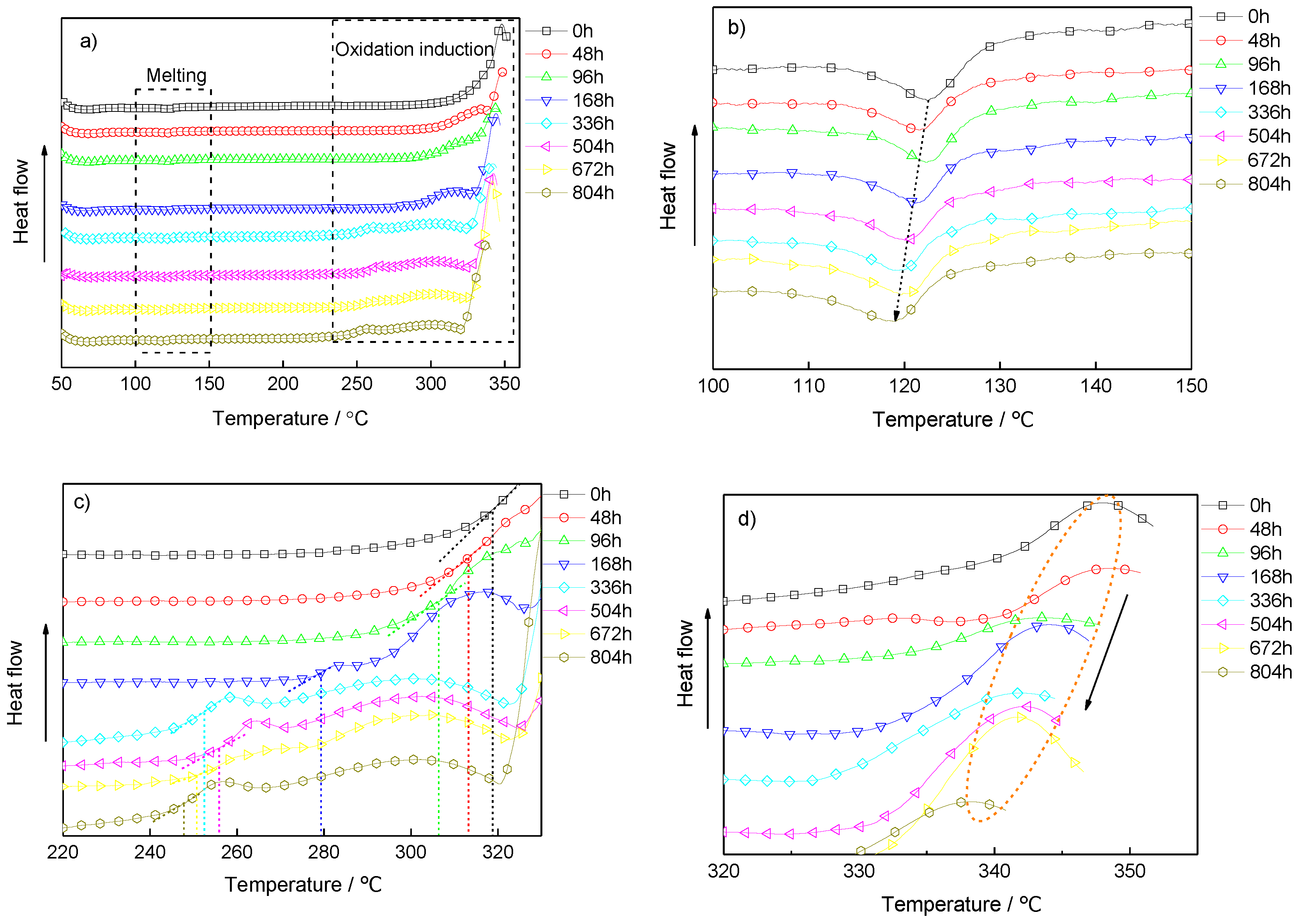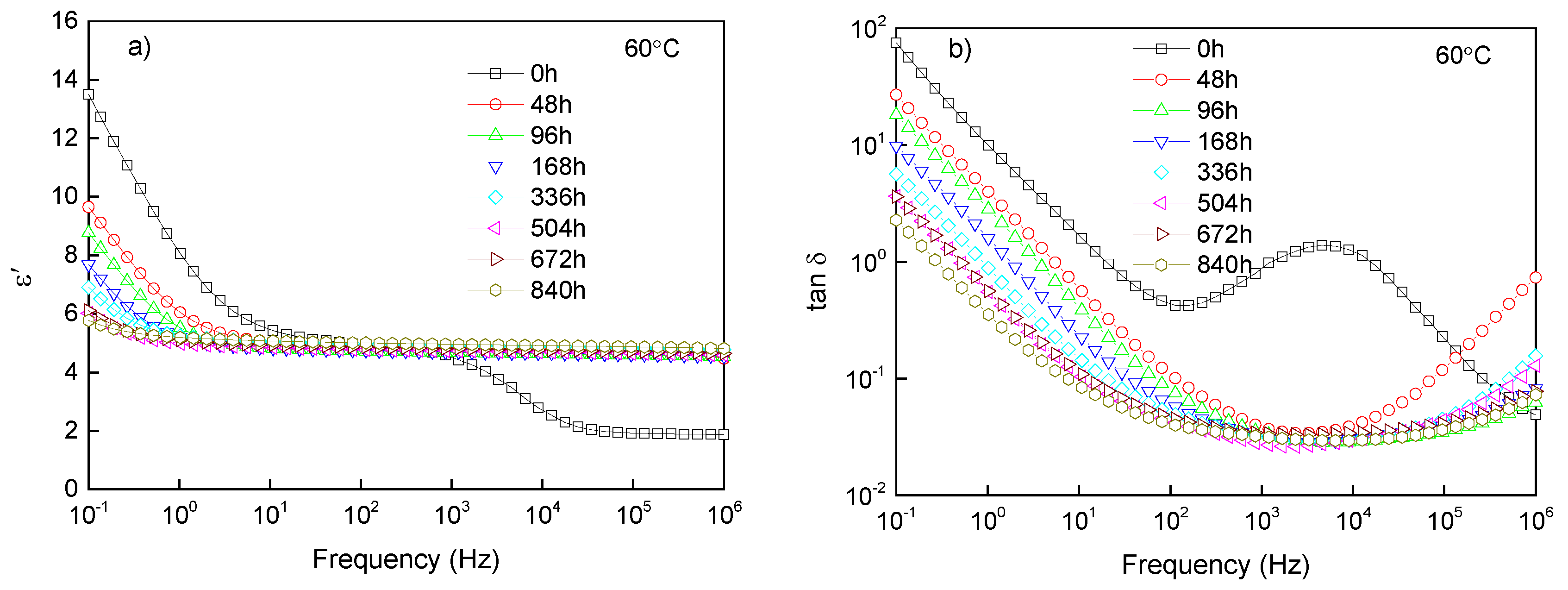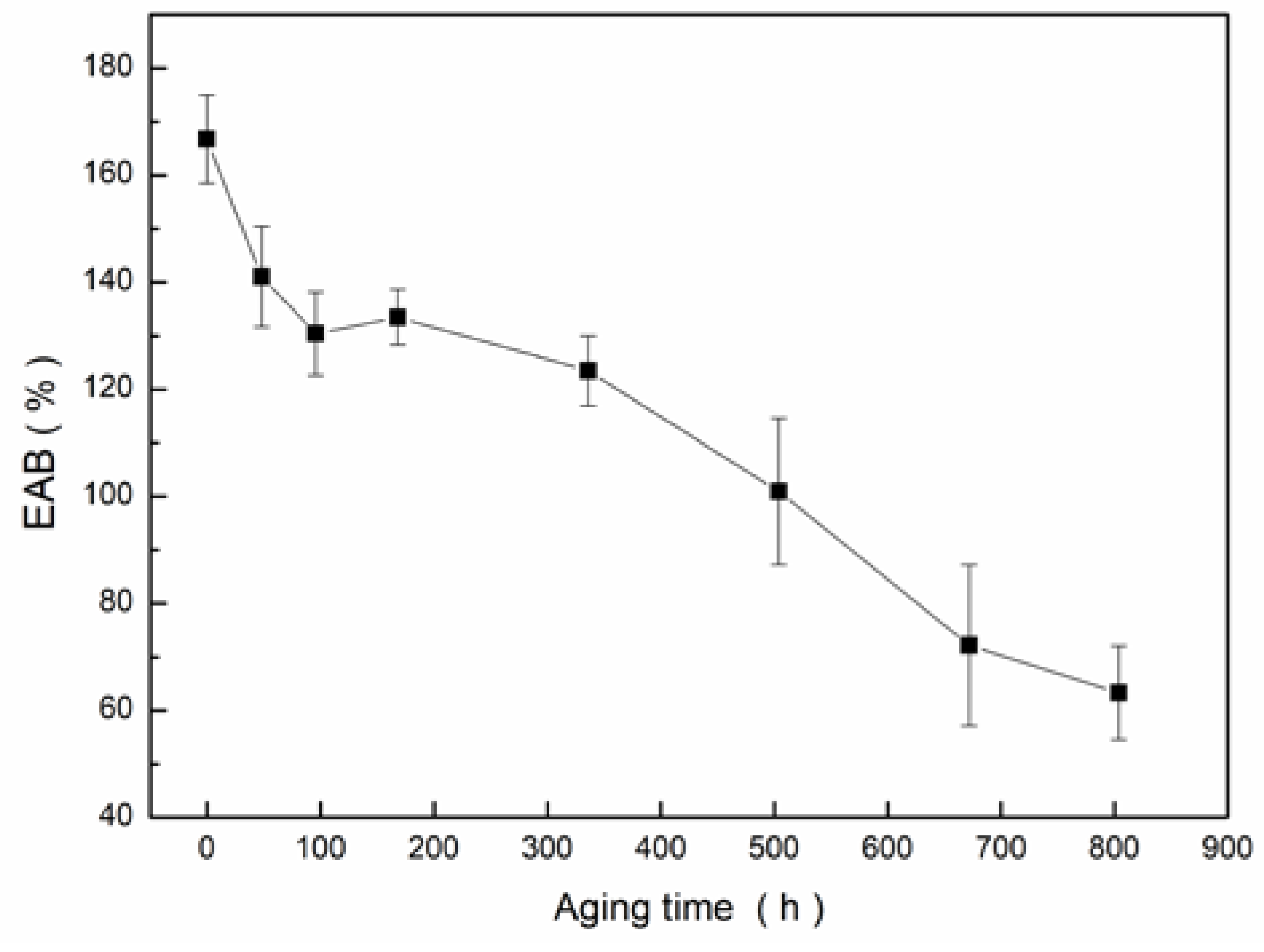Thermal-Oxidative Aging Effects on the Dielectric Properties of Nuclear Cable Insulation
Abstract
:1. Introduction
2. Materials and Methods
2.1. Samples Preparation
2.2. Thermal-Oxidative Aging
2.3. Chemical and Thermal Testing
2.4. Dielectric Properties Testing
2.5. Tensile Testing
3. Results and Discussion
3.1. Chemical Structural Analysis
3.2. Melting and Oxidative-Induced Properties
3.3. Dielectric Properties
3.3.1. Polarized and Loss Characteristics
3.3.2. Conductivity Characteristic
3.3.3. Breakdown Strength
3.4. Tensile Testing
4. Conclusions
Author Contributions
Funding
Acknowledgments
Conflicts of Interest
References
- IAEA Power Reactor Information System. Available online: https://pris.iaea.org/pris (accessed on 31 December 2019).
- World Nuclear Association. Available online: http://www.world-nuclear.org (accessed on 31 December 2019).
- China Nuclear Energy Association. Available online: http://www.china-nea.cn (accessed on 31 December 2019).
- Zohuri, B. Small Modular Reactors as Renewable Energy Sources; Springer International Publishing: Cham, Switzerland, 2018; ISBN 9783319925943. [Google Scholar]
- Tanaka, Y.; Sato, I. Development of high purity large forgings for nuclear power plants. J. Nucl. Mater. 2011, 417, 854–859. [Google Scholar] [CrossRef]
- Ghorashi, A.H. Prospects of nuclear power plants for sustainable energy development in Islamic Republic of Iran. Energy Policy 2007, 35, 1643–1647. [Google Scholar] [CrossRef]
- Ge, W.; Sun, P.; Li, J.; Zhang, T.; Zhang, Q.; Wang, C. Research on Economic Operation of Multi-Source Peak-Shaving Involving Nuclear Power. In Proceedings of the 2018 International Conference on Smart Grid and Electrical Automation (ICSGEA), Changsha, China, 9–10 June 2018; pp. 46–49. [Google Scholar]
- Glass, S.W.; Ramuhalli, P.; Fifield, L.S.; Prowant, M.S.; Dib, G.; Tedeschi, J.R.; Suter, J.D.; Jones, A.M.; Good, M.S.; Pardini, A.F.; et al. Assessment of NDE for key indicators of aging cables in nuclear power plants-nterim status. AIP Conf. Proc. 2016, 1706, 170006. [Google Scholar]
- Chang, Y.S.; Mosleh, A. Probabilistic model of degradation of cable insulations in nuclear power plants. Proc. Inst. Mech. Eng. Part O J. Risk Reliab. 2019, 233, 803–814. [Google Scholar] [CrossRef]
- Verardi, L.; Fabiani, D.; Montanari, G.C. Correlation of Electrical and Mechanical Properties in Accelerated Aging of LV Nuclear Power Plant Cables. In Proceedings of the 2014 ICHVE International Conference on High Voltage Engineering and Application, Poznan, Poland, 8–11 September 2014; pp. 1–4. [Google Scholar]
- Verardi, L.; Fabiani, D.; Montanari, G.C. Electrical aging markers for EPR-based low-voltage cable insulation wiring of nuclear power plants. Radiat. Phys. Chem. 2014, 94, 166–170. [Google Scholar] [CrossRef]
- Boukezzi, L.; Boubakeur, A. Effect of Thermal Aging on the Electrical Characteristics of XLPE for HV Cables. Trans. Electr. Electron. Mater. 2018, 19, 344–351. [Google Scholar] [CrossRef]
- Verardi, L.; Fabiani, D.; Montanari, G.C.; Zak, P. Electrical Condition Monitoring Techniques for Low-Voltage Cables Used in Nuclear Power Plants. In Proceedings of the 2013 IEEE Electrical Insulation Conference (EIC), Ottawa, ON, Canada, 2–5 June 2013; pp. 504–508. [Google Scholar]
- Banford, H.M.; Fouracre, R.A.; MacGregor, S.J.; Judd, M. An Investigation of Radiation-Induced Ageing in Cable Insulation via Loss Measurements at High and Low Frequencies. In Proceedings of the Conference Record of the 1998 IEEE International Symposium on Electrical Insulation (Cat. No.98CH36239), Arlington, VA, USA, 7–10 June 1998; Volume 2, pp. 558–561. [Google Scholar]
- Ma, Z.S.; Shan, Y.D.; Li, J.X. Development of Low Temperature and Low Smoke Halogen Free Flame Retardant Cable Material. Electr. Wire Cable 2016, 33, 10–13. [Google Scholar]
- Hamouya, M.; Mahir, A.; Idrissi, M.C.E. Natural Ageing of Stabilized and Unstabilized Ldpe Films: Xrd and Sem Analysis. Int. J. Res. Eng. Technol. 2014, 3, 210–215. [Google Scholar]
- Liu, S.; Veysey, S.W.; Fifield, L.S.; Bowler, N. Quantitative analysis of changes in antioxidant in crosslinked polyethylene (XLPE) cable insulation material exposed to heat and gamma radiation. Polym. Degrad. Stab. 2018, 156, 252–258. [Google Scholar] [CrossRef] [Green Version]
- Sugimoto, M.; Shimada, A.; Kudoh, H.; Tamura, K.; Seguchi, T. Product analysis for polyethylene degradation by radiation and thermal ageing. Radiat. Phys. Chem. 2013, 82, 69–73. [Google Scholar] [CrossRef]
- Tantipattarakul, S.; Vaughan, A.S.; Andritsch, T. On the influence of morphology and chemical defects on charge transport dynamics in polyethylene: Thermal ageing and concentration gradient. J. Phys. D Appl. Phys. 2019, 52, 395302. [Google Scholar] [CrossRef]
- Minakawa, T.; Ikeda, M.; Hirai, N.; Ohki, Y. Aging State Analysis of Safety-Related Cables for Nuclear Power Plants Exposed to Simulated Accident Conditions. In Proceedings of the 2018 IEEE Conference on Electrical Insulation and Dielectric Phenomena (CEIDP), Cancun, Mexico, 21–24 October 2018; pp. 602–605. [Google Scholar]
- Hosier, I.L.; Vaughan, A.S.; Swingler, S.G. An investigation of the potential of ethylene vinyl acetate/polyethylene blends for use in recyclable high voltage cable insulation systems. J. Mater. Sci. 2010, 45, 2747–2759. [Google Scholar] [CrossRef]
- Mujal-Rosas, R.; Orrit-Prat, J.; Ramis-Juan, X.; Marin-Genesca, M.; Rahhali, A. Study on dielectric, thermal, and mechanical properties of the ethylene vinyl acetate reinforced with ground tire rubber. J. Reinf. Plast. Compos. 2011, 30, 581–592. [Google Scholar] [CrossRef]
- Lindqvist, K.; Andersson, M.; Boss, A.; Oxfall, H. Thermal and Mechanical Properties of Blends Containing PP and Recycled XLPE Cable Waste. J. Polym. Environ. 2019, 27, 386–394. [Google Scholar] [CrossRef]
- Pirc, M.; Avsec, J.; Korošin, N.Č.; Štangar, U.L.; Korošec, R.C. Cable aging monitoring with differential scanning calorimetry (DSC) in nuclear power plants. Trans. Famena 2018, 42, 87–98. [Google Scholar] [CrossRef] [Green Version]
- Wang, Y.; Zhao, A.; Zhang, X.; Shen, Y.; Yang, F.; Deng, J.; Zhang, G. Study of Dielectric Response Characteristics for Thermal Aging of XLPE Cable Insulation. In Proceedings of the 2016 International Conference on Condition Monitoring and Diagnosis (CMD), Xi’an, China, 25–28 September 2016; pp. 602–605. [Google Scholar]
- Kim, C.; Jin, Z.; Jiang, P.; Zhu, Z.; Wang, G. Investigation of dielectric behavior of thermally aged XLPE cable in the high-frequency range. Polym. Test. 2006, 25, 553–561. [Google Scholar] [CrossRef]
- Fabiani, D.; Suraci, S.V.; Bulzaga, S. Aging Investigation of Low-Voltage Cable Insulation Used in Nuclear Power Plants. In Proceedings of the 2018 IEEE Electrical Insulation Conference (EIC), San Antonio, TX, USA, 17–20 June 2018; pp. 516–519. [Google Scholar]
- Zhang, C.; Zhang, H.; Li, C.; Duan, S.; Jiang, Y.; Yang, J.; Han, B.; Zhao, H. Crosslinked polyethylene/polypyrrole nanocomposites with improved direct current electrical characteristics. Polym. Test. 2018, 71, 223–230. [Google Scholar] [CrossRef]
- Faezah, H.N.; Azreen, M.A.M.; Lau, K.Y.; Lee, H.S. Breakdown properties of aged low voltage cross-linked polyethylene insulated cable. IOP Conf. Ser. Mater. Sci. Eng. 2019, 513, 012014. [Google Scholar] [CrossRef]
- Chi, X.H.; Cheng, L.; Liu, W.F.; Zhang, X.H.; Li, S.T. Dynamic mechanism of breakdown in polypropylene-based nano-dielectric. AIP Adv. 2019, 9, 015135. [Google Scholar] [CrossRef] [Green Version]
- Chi, X.; Gao, J.; Zhang, X. Electrical tree propagating characteristics of polyethylene/nano-montmorillonite composites. IEEE Trans. Dielectr. Electr. Insul. 2015, 22, 1530–1536. [Google Scholar] [CrossRef]
- Anandakumaran, K. Aging and condition monitoring studies of composite insulation cables used in nuclear power plants. IEEE Trans. Dielectr. Electr. Insul. 2007, 14, 227–237. [Google Scholar] [CrossRef]






© 2020 by the authors. Licensee MDPI, Basel, Switzerland. This article is an open access article distributed under the terms and conditions of the Creative Commons Attribution (CC BY) license (http://creativecommons.org/licenses/by/4.0/).
Share and Cite
Chi, X.; Li, J.; Ji, M.; Liu, W.; Li, S. Thermal-Oxidative Aging Effects on the Dielectric Properties of Nuclear Cable Insulation. Materials 2020, 13, 2215. https://doi.org/10.3390/ma13102215
Chi X, Li J, Ji M, Liu W, Li S. Thermal-Oxidative Aging Effects on the Dielectric Properties of Nuclear Cable Insulation. Materials. 2020; 13(10):2215. https://doi.org/10.3390/ma13102215
Chicago/Turabian StyleChi, Xiaohong, Jianxi Li, Minzun Ji, Wenfeng Liu, and Shengtao Li. 2020. "Thermal-Oxidative Aging Effects on the Dielectric Properties of Nuclear Cable Insulation" Materials 13, no. 10: 2215. https://doi.org/10.3390/ma13102215




